Mobile Workstation - Professional's Choice
According to the World Advantage 2016 Trends 2016 Survey report compiled by Business Advantage, currently more than half of CAD users in the world (56%) use desktop workstations, 42% use standard desktop PCs, and 33% use portable computers. According to forecasts, these proportions in the coming years will change in favor of mobile systems.
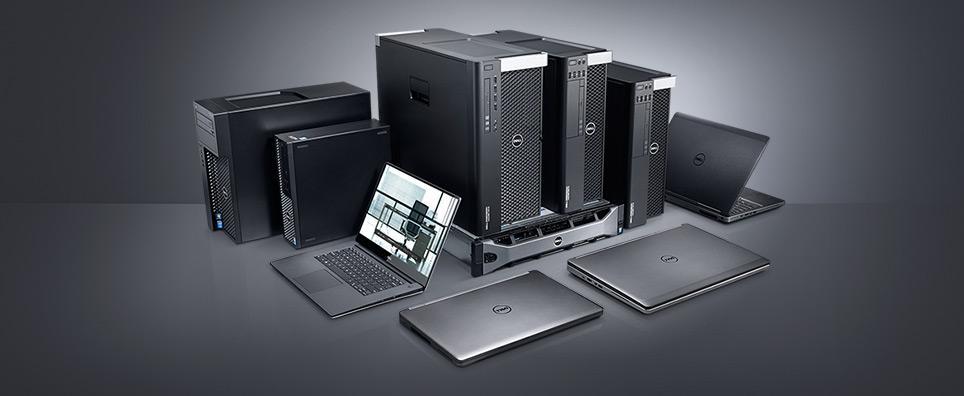
What makes buying such computers? Why not choose a custom-built laptop for Windows 10 that is more powerful? Why precisely workstation? This is a dilemma faced by many companies and professionals. To answer this question, you need to start with the concept itself.

As expected, in the coming years, the demand for desktop workstations for CAD will fall, and for mobile - growth (source: Business Advantage ).
')
Workstations are professional computers with a set of hardware and software designed to solve a specific range of tasks: multimedia (image processing, video recording, sound), CAD, GIS, scientific and technical calculations, the launch of industrial applications, work in the "field conditions", etc. .
The first workstations appeared in the late 1960s, and today they are widely used in video editing, 2D and 3D graphics, computer-aided design and engineering, as well as other resource-intensive computations. With the release of 64-bit versions of the Windows operating systems, high-performance UNIX workstations with proprietary software environments have given way to Windows and Linux systems.
The workstation can be used both at various enterprises and at home. Today, more and more professional users - specialists in computer-aided design and modeling, graphic artists, animators, photographers and video editors - are partially or completely moving to work in home offices. They need systems of increased computing power and functionality. What distinguishes a workstation from a “simple” computer?
PCs and workstations use similar basic technologies, but the developers of the latter pay special attention to the reliability of the system and optimizing its performance for special applications: CAD, multimedia, geo-information, financial and others, depending on the purpose of the system, which is essentially a hardware-software complex. .
When processing geospatial data, building three-dimensional terrain models and other similar tasks on standard PCs, one has to deal with a lack of memory, delays and “hang-ups”, while workstations demonstrate high performance and do a good job with data visualization.
A workstation is not just a computer, it is a whole range of mechanisms designed to perform the most demanding tasks, ensure uninterrupted operation and advanced functionality.
The distinctive features of modern workstations, distinguishing them in the PC series, are high speed of work with data, powerful processor, large capacity of fast RAM, integrated high-performance network controller, professional graphic subsystem. Thus, although the boundary between low-end workstations and PCs is very blurred, they actually surpass ordinary desktops or laptops in all respects, including gaming models.
Professional workstations are designed to perform priority business tasks and place high demands on system performance and reliability, so they use high-quality components, and workstations themselves undergo a rigorous testing process. They are designed for smooth operation and a long cycle of operation. Designers and designers using workstations perform responsible tasks and must clearly meet the deadlines, and the failure of the PC can adversely affect business processes.
Automated design packages require high performance for working with complex layouts, so they use professional-level processors and graphics cards. This allows, for example, the design engineer to quickly analyze the results of each phase of the project, to promptly make changes.
A typical workstation for CAD in a desktop form factor is a system based on an Intel Core i7 / Intel Xeon E5 processor with high-speed DDR4 memory with ECC, NVIDIA Quadro or AMD FirePro graphics card. Mobile workstations have similar equipment, but they use less powerful “mobile” analogues of system components. Mobile graphic stations are designed for those who move a lot, but want to always have a high-performance workplace at hand.
Typical applications for mobile graphics workstations are 3D modeling of parts, working with small and medium assemblies; design and architectural design; organization of a productive mobile workplace where necessary.

Mobile workstations are currently being built on sixth-generation Intel Core processors (Skylake-H), some of which are mobile Xeon processors. Using DDR4 memory allowed to increase not only the frequency, but also the memory capacity. Some systems have 4 × SODIMM slots - up to 64 GB of RAM, which is important for applications that actively use it.
As soon as M.2 drives appeared with a PCIe 3.0 × 4 interface and support in Intel chipsets up to 16 PCI Express 3.0 lanes, the disk subsystem ceased to be a bottleneck. Thanks to the USB 3.1 Gen2 ports and the Thunderbolt interface, you can use external drives (disk arrays).
The most important difference between a workstation of any form factor and a PC is its certification for working with specialized applications.
Professional-grade graphics cards are distinguished from ordinary products of this class with certification to support special applications, driver optimization and stability, as well as additional functionality determined by the specifics of the application software. In addition, graphics vendors for professionals, most notably AMD and NVIDIA, typically provide an extended user support period of 18 months.

Certification is one of the key features of workstations. Independent Software Vendor Certification - the result of a thoughtful development process and thorough testing. It ensures that the applications that have completed this procedure will work reliably and with maximum performance. Certified workstations meet the specific features of application tasks, provide high performance and stability of key operating parameters, and optimal load distribution between the CPU and GPU.
To optimize their drivers, AMD and NVIDIA work with leading software developers: Adobe, Autodesk, Dassault, and others. Workstations and GPUs are tested and certified to work with hundreds of CAD / CAM / CAE software packages.
Workstations CAD - a subclass of graphic workstations - allow you to create design and / or technological documentation, geometric models (solid-state, three-dimensional, composite), as well as product drawings. The hardware resources of such a workstation involve all the functionality of professional CAD systems: CATIA, CREO, NX, Inventor, Compass, AutoCAD, Solid Works, SolidEdge, T-Flex CAD and others.
Graphic workstations for design automation systems (CAD) represent a wide class of systems for CAD (Computer Aided Design), CAM (Computer Aided Manufacturing) and CAE (Computer Aided Engineering) tasks. Modern CAD workstations are conventionally divided into the following groups:
In workstations designed for CAD and video editing, professional graphics cards NVIDIA and AMD are now widely used. Drivers designed for NVIDIA Quadro and AMD FirePro cards make it possible to optimally use hardware and software, the capabilities of which, as a result, are far superior to what non-professional graphics can offer. It is important to use the latest drivers: they are regularly optimized, profiles are updated, support for new versions of CAD, etc. appears.
In calculations with graphic acceleration, in addition to the central processor, a graphic processor (GPU) is used. This allows you to improve the performance of graphics applications, computing tasks, analytics and design, accelerate modeling for the automotive and oil and gas industries, aircraft manufacturing, media content production, medical data processing and research data.
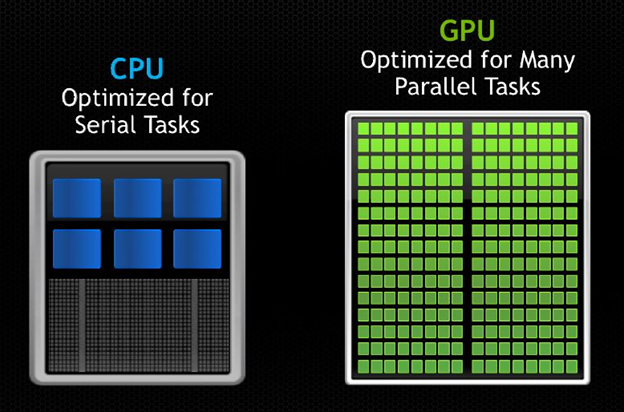
The CPU is optimized mainly for serial, GPU - for parallel tasks. Well-parallelizable and graphical tasks are performed on the GPU. Thus, an increase in the performance of the graphics core and the application as a whole is achieved.
Unlike central processing units (CPUs), in modern graphics accelerators (GPUs), depending on the model, more than 512 cores are available, and with the help of specialized APIs, you can get a high increase in computation speed in well-parallel tasks.
AMD, in its professional graphics cards, uses the same GCN (Graphics Core Next) architecture based on RISC SIMD as in game cards, as well as HyperZ technology (hierarchical Z-buffering and Z-rasterization with 4 bytes per pixel). Innovations from AMD are expected after the transition in 2017 to a new 14-nm process technology and the fourth version of GCN. In the second half of 2017, AMD Vega dual processor card with a capacity of about 23 teraflops should be released.
NVIDIA and AMD also have a line of professional mobile graphics cards. As a rule, the mobile analogue of the graphics system is somewhat "weaker" in terms of its main characteristics than its "stationary" prototype, which is explained by significant limitations in mobile performance in terms of dimensions and power consumption. Using laptops as CAD workstations is nevertheless fully justified and popular. For example, it is now possible to engage in large projects on the road. With a weight of just over 2 kg, such systems are full-featured workstations with a graphics adapter, professional-class drives and processors. Compactness no longer means low productivity.
The new Dell Precision 15 (3510) mobile workstation is one of the good examples of the development of mobile productivity for CAD. Compared to the previous version, processor performance is higher by about 15%, graphics - by 20%, RAM speed - by 33%. SSD drives have become 3 times faster, and their capacity reaches 1 TB. The system can also be equipped with 2.5-inch SATA hard disk drives with a capacity of 0.5 to 1 TB (5400 or 7200 rpm), which allow storing the largest and most complex projects.
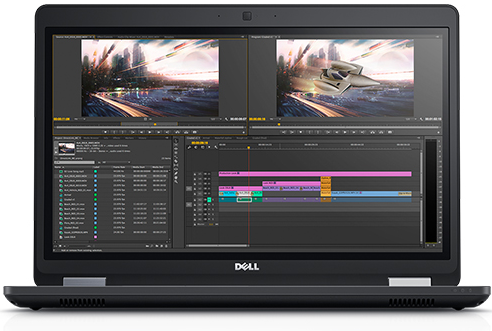
Different screens are available for the Dell Precision 15 (3510): low-cost 15.6-inch high-definition HD TN 1366 × 768; Full HD IPS 1920 × 1080 resolution displays and a touch screen with tracking of 10 touch points. On board - a quad-core Intel Xeon E3-1505M processor (2.8 GHz, 8 MB cache), or Intel Core i5 6300 / 6440HQ (2.3-2.6 GHz, 6 MB cache), or Intel Core i7 6820HQ (2.7 GHz, cache - 8 MB).

The newly designed case made it possible to make the workstation 26% thinner and 12% lighter than the previous model, the touchpad became larger, and it was easier to work with it.
Dell Precision 15 (3510) received a display with QHD or 4K resolution, Skylake microarchitecture processors (quad-core Intel Core i5 and i7 processors of the sixth generation), Thunderbolt 3.0 interfaces (up to 40 Gbit / s) and USB Type C. You can connect it simultaneously to four 4K monitors.

1. Headphone jack. 2. Memory card reader. 3. USB 3.0. 4. USB 3.0. 5. Security lock. 6. RJ45 port. 7. VGA port. 8. SIM card slot. 9. HDMI. 10. USB 3.0. 11. Power adapter port. 12. USB-C port. 13. Smart card reader .
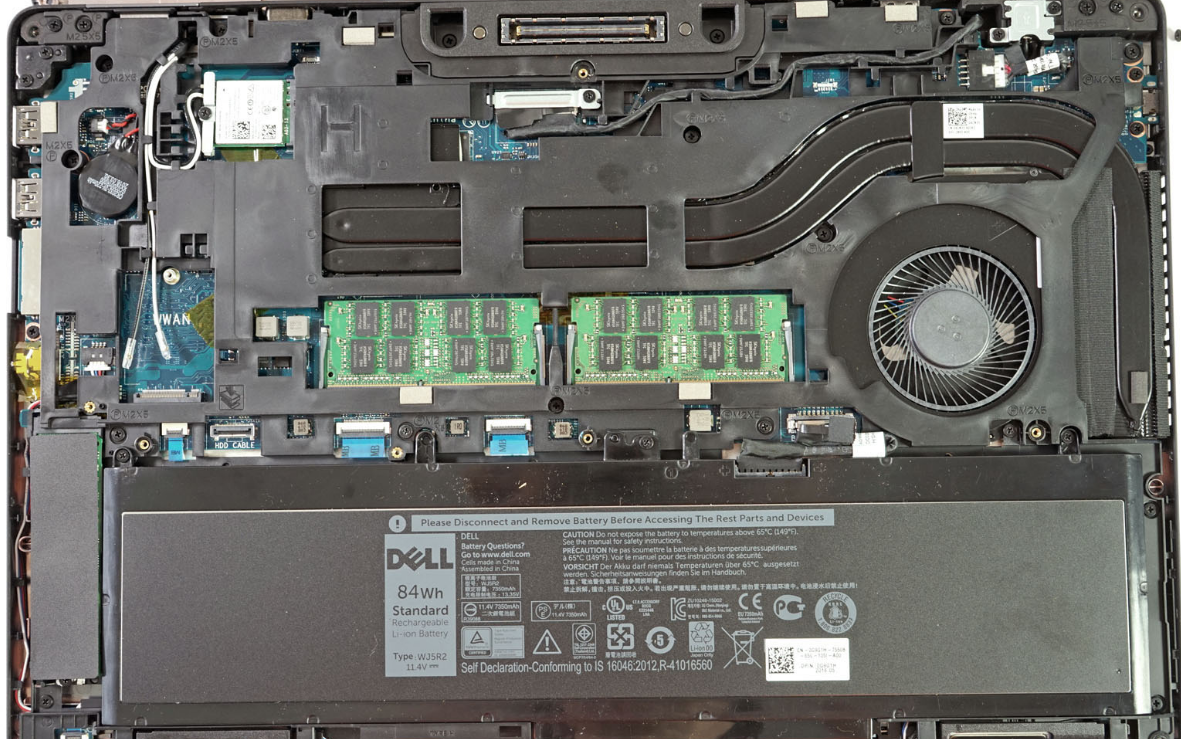
Dell Precision 15 (3510) Insides: Battery, Dual Memory, Fan.
The systems are equipped with DDR4 2133 MHz RAM (up to 32 GB) and AMD FirePro graphics adapters with 2 GB of GDDR5 memory. They provide higher performance than consumer-level graphics cards in a variety of tasks: from drawing to complex modeling. Another option is the integrated graphics adapter Intel HD Graphics 530 or Intel HD Graphics P530.
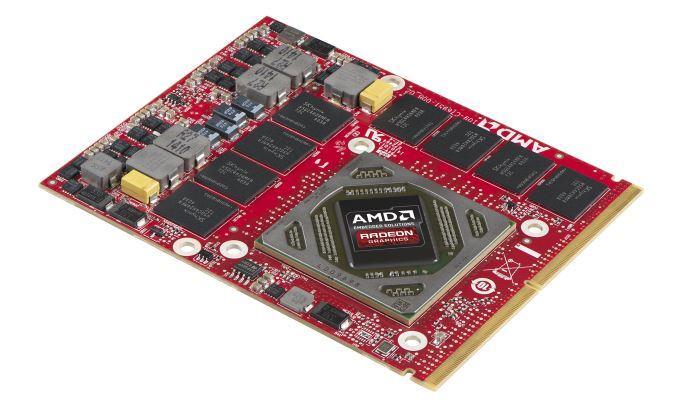
The AMD FirePro W5130M graphics card contains 512 cores and a 128-bit GDDR5 graphics card. Its performance in OpenGL significantly exceeds the performance of GeForce video cards with similar specifications.
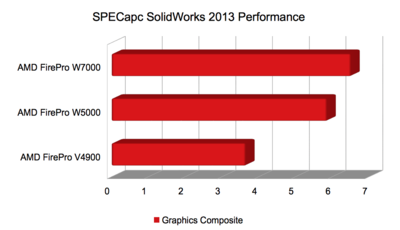
All AMD FirePro W-series cards are based on GCN (Graphics Core Next) GPU architecture, that is, in fact, are professional modifications of the Radeon HD 7000 series. AMD FirePro W5130M is a middle class card, the best combination of price and performance.

In independent performance tests, the workstation shows decent results.
Dell thoroughly tests its workstations with independent software vendors: Autodesk, Adobe, Solidworks, and others to ensure that Precision works harmoniously with specialized software and improve the quality of technical support from Dell ProSupport Plus.
Independent Software Vendor Certification on Dell systems covers the most popular third-party applications (technical design applications, scientific calculation packages, multimedia). From operating systems, in addition to the recommended Windows 10 Pro, you can choose Ubuntu or FreeDOS. An important competitive difference between the workstation is software optimization.
Different applications have different system requirements. The preinstalled software package includes the Dell Precision Optimizer, which can be managed from the central console of the System Center Configuration Manager (SCCM). Precision Optimizer automatically adjusts the system to work optimally with a specific professional application and achieve maximum performance. For example, SolidWorks application performance improves as a result by about 55%.
In addition, Dell Precision Optimizer provides real-time reports on CPU, storage, memory, and graphics usage, and sends system status reports for analysis to the IT department.

The Dell Precision Optimizer tool, shipped free of charge from the Precision Workstation, provides automatic system tuning to optimize the performance of the most popular applications.
Dell Precision workstations also offer a variety of accessories, including docking stations and various peripherals.
Even a relatively inexpensive low-end workstation such as the Dell Precision 15 (3510) provides far more business opportunities than a standard laptop. Attempting to save and use for the professional work of a system not intended for this purpose will lead to a loss of productivity and a breakdown of the project deadlines. As a result, you will have to pay double the price. As the implementation examples show (in particular, the experience of the Japanese company Takenaka , which uses 60 mobile workstations of Dell Precision 15 (3510)), customers manage to get a number of tangible benefits:
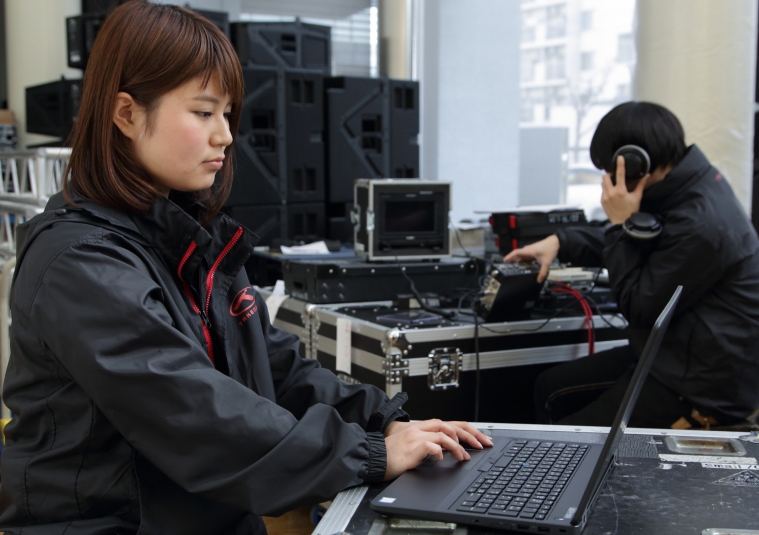

What makes buying such computers? Why not choose a custom-built laptop for Windows 10 that is more powerful? Why precisely workstation? This is a dilemma faced by many companies and professionals. To answer this question, you need to start with the concept itself.

As expected, in the coming years, the demand for desktop workstations for CAD will fall, and for mobile - growth (source: Business Advantage ).
')
What is a workstation?
Workstations are professional computers with a set of hardware and software designed to solve a specific range of tasks: multimedia (image processing, video recording, sound), CAD, GIS, scientific and technical calculations, the launch of industrial applications, work in the "field conditions", etc. .
The first workstations appeared in the late 1960s, and today they are widely used in video editing, 2D and 3D graphics, computer-aided design and engineering, as well as other resource-intensive computations. With the release of 64-bit versions of the Windows operating systems, high-performance UNIX workstations with proprietary software environments have given way to Windows and Linux systems.
The workstation can be used both at various enterprises and at home. Today, more and more professional users - specialists in computer-aided design and modeling, graphic artists, animators, photographers and video editors - are partially or completely moving to work in home offices. They need systems of increased computing power and functionality. What distinguishes a workstation from a “simple” computer?
The difference between a workstation and a PC
PCs and workstations use similar basic technologies, but the developers of the latter pay special attention to the reliability of the system and optimizing its performance for special applications: CAD, multimedia, geo-information, financial and others, depending on the purpose of the system, which is essentially a hardware-software complex. .
When processing geospatial data, building three-dimensional terrain models and other similar tasks on standard PCs, one has to deal with a lack of memory, delays and “hang-ups”, while workstations demonstrate high performance and do a good job with data visualization.
A workstation is not just a computer, it is a whole range of mechanisms designed to perform the most demanding tasks, ensure uninterrupted operation and advanced functionality.
The distinctive features of modern workstations, distinguishing them in the PC series, are high speed of work with data, powerful processor, large capacity of fast RAM, integrated high-performance network controller, professional graphic subsystem. Thus, although the boundary between low-end workstations and PCs is very blurred, they actually surpass ordinary desktops or laptops in all respects, including gaming models.
Professional workstations are designed to perform priority business tasks and place high demands on system performance and reliability, so they use high-quality components, and workstations themselves undergo a rigorous testing process. They are designed for smooth operation and a long cycle of operation. Designers and designers using workstations perform responsible tasks and must clearly meet the deadlines, and the failure of the PC can adversely affect business processes.
Automated design packages require high performance for working with complex layouts, so they use professional-level processors and graphics cards. This allows, for example, the design engineer to quickly analyze the results of each phase of the project, to promptly make changes.
A typical workstation for CAD in a desktop form factor is a system based on an Intel Core i7 / Intel Xeon E5 processor with high-speed DDR4 memory with ECC, NVIDIA Quadro or AMD FirePro graphics card. Mobile workstations have similar equipment, but they use less powerful “mobile” analogues of system components. Mobile graphic stations are designed for those who move a lot, but want to always have a high-performance workplace at hand.
Mobile Workstations
Typical applications for mobile graphics workstations are 3D modeling of parts, working with small and medium assemblies; design and architectural design; organization of a productive mobile workplace where necessary.

Mobile workstations are currently being built on sixth-generation Intel Core processors (Skylake-H), some of which are mobile Xeon processors. Using DDR4 memory allowed to increase not only the frequency, but also the memory capacity. Some systems have 4 × SODIMM slots - up to 64 GB of RAM, which is important for applications that actively use it.
As soon as M.2 drives appeared with a PCIe 3.0 × 4 interface and support in Intel chipsets up to 16 PCI Express 3.0 lanes, the disk subsystem ceased to be a bottleneck. Thanks to the USB 3.1 Gen2 ports and the Thunderbolt interface, you can use external drives (disk arrays).
The most important difference between a workstation of any form factor and a PC is its certification for working with specialized applications.
Professional graphics and certification of workstations by application developers
Professional-grade graphics cards are distinguished from ordinary products of this class with certification to support special applications, driver optimization and stability, as well as additional functionality determined by the specifics of the application software. In addition, graphics vendors for professionals, most notably AMD and NVIDIA, typically provide an extended user support period of 18 months.

Certification is one of the key features of workstations. Independent Software Vendor Certification - the result of a thoughtful development process and thorough testing. It ensures that the applications that have completed this procedure will work reliably and with maximum performance. Certified workstations meet the specific features of application tasks, provide high performance and stability of key operating parameters, and optimal load distribution between the CPU and GPU.
To optimize their drivers, AMD and NVIDIA work with leading software developers: Adobe, Autodesk, Dassault, and others. Workstations and GPUs are tested and certified to work with hundreds of CAD / CAM / CAE software packages.
CAD workstations
Workstations CAD - a subclass of graphic workstations - allow you to create design and / or technological documentation, geometric models (solid-state, three-dimensional, composite), as well as product drawings. The hardware resources of such a workstation involve all the functionality of professional CAD systems: CATIA, CREO, NX, Inventor, Compass, AutoCAD, Solid Works, SolidEdge, T-Flex CAD and others.
| View CAD | Solvable tasks |
| Engineering | Development of a wide range of products: from the creation of aerospace systems to the design of household appliances. |
| Microelectronics Products | Design of circuit and wiring diagrams, printed circuit boards, automatic placement of items of products, autotracing. |
| Electrotechnical | Development of schematic diagrams and electrical equipment connection diagrams, its spatial layout, maintenance of databases of finished products. |
| Architectural | 2D and 3D design of architectural and building structures, the calculation of special structures (for example, roofs), typical static calculations of building structures, maintenance of databases of standard elements, planning of territories for construction. |
| Equipment for industrial installations and structures | Creation of schematic diagrams of installations, spatial wiring of pipelines and cable routes, design of heating, water supply, sewerage, electricity, ventilation and air conditioning systems, maintenance of equipment databases, pipeline fittings, finished electrical products. |
| Geoinformation | Digitizing field survey data, analyzing geodetic networks, building a digital elevation model, creating maps and plans in vector form, maintaining land and city cadastres, maintaining an electronic cartographic archive. |
Graphic workstations for design automation systems (CAD) represent a wide class of systems for CAD (Computer Aided Design), CAM (Computer Aided Manufacturing) and CAE (Computer Aided Engineering) tasks. Modern CAD workstations are conventionally divided into the following groups:
| CAD workstations | Workstation Applications |
| First level | 2D modeling of products, working with small assemblies in 3D; entry-level design and architectural design. |
| Average level | 3D modeling of parts, work with small and medium assemblies; design and architectural design. |
| High-end Workstations | High performance computing using specialized software, engineering analysis and simulation modeling; preparing photorealistic images (rendering); video processing and effects overlay; work with super large assemblies. |
In workstations designed for CAD and video editing, professional graphics cards NVIDIA and AMD are now widely used. Drivers designed for NVIDIA Quadro and AMD FirePro cards make it possible to optimally use hardware and software, the capabilities of which, as a result, are far superior to what non-professional graphics can offer. It is important to use the latest drivers: they are regularly optimized, profiles are updated, support for new versions of CAD, etc. appears.
Graphic and video cards
In calculations with graphic acceleration, in addition to the central processor, a graphic processor (GPU) is used. This allows you to improve the performance of graphics applications, computing tasks, analytics and design, accelerate modeling for the automotive and oil and gas industries, aircraft manufacturing, media content production, medical data processing and research data.

The CPU is optimized mainly for serial, GPU - for parallel tasks. Well-parallelizable and graphical tasks are performed on the GPU. Thus, an increase in the performance of the graphics core and the application as a whole is achieved.
Unlike central processing units (CPUs), in modern graphics accelerators (GPUs), depending on the model, more than 512 cores are available, and with the help of specialized APIs, you can get a high increase in computation speed in well-parallel tasks.
AMD, in its professional graphics cards, uses the same GCN (Graphics Core Next) architecture based on RISC SIMD as in game cards, as well as HyperZ technology (hierarchical Z-buffering and Z-rasterization with 4 bytes per pixel). Innovations from AMD are expected after the transition in 2017 to a new 14-nm process technology and the fourth version of GCN. In the second half of 2017, AMD Vega dual processor card with a capacity of about 23 teraflops should be released.
NVIDIA and AMD also have a line of professional mobile graphics cards. As a rule, the mobile analogue of the graphics system is somewhat "weaker" in terms of its main characteristics than its "stationary" prototype, which is explained by significant limitations in mobile performance in terms of dimensions and power consumption. Using laptops as CAD workstations is nevertheless fully justified and popular. For example, it is now possible to engage in large projects on the road. With a weight of just over 2 kg, such systems are full-featured workstations with a graphics adapter, professional-class drives and processors. Compactness no longer means low productivity.
Dell Precision 15 Mobile Workstation (3510)
The new Dell Precision 15 (3510) mobile workstation is one of the good examples of the development of mobile productivity for CAD. Compared to the previous version, processor performance is higher by about 15%, graphics - by 20%, RAM speed - by 33%. SSD drives have become 3 times faster, and their capacity reaches 1 TB. The system can also be equipped with 2.5-inch SATA hard disk drives with a capacity of 0.5 to 1 TB (5400 or 7200 rpm), which allow storing the largest and most complex projects.

Different screens are available for the Dell Precision 15 (3510): low-cost 15.6-inch high-definition HD TN 1366 × 768; Full HD IPS 1920 × 1080 resolution displays and a touch screen with tracking of 10 touch points. On board - a quad-core Intel Xeon E3-1505M processor (2.8 GHz, 8 MB cache), or Intel Core i5 6300 / 6440HQ (2.3-2.6 GHz, 6 MB cache), or Intel Core i7 6820HQ (2.7 GHz, cache - 8 MB).

The newly designed case made it possible to make the workstation 26% thinner and 12% lighter than the previous model, the touchpad became larger, and it was easier to work with it.
Dell Precision 15 (3510) received a display with QHD or 4K resolution, Skylake microarchitecture processors (quad-core Intel Core i5 and i7 processors of the sixth generation), Thunderbolt 3.0 interfaces (up to 40 Gbit / s) and USB Type C. You can connect it simultaneously to four 4K monitors.

1. Headphone jack. 2. Memory card reader. 3. USB 3.0. 4. USB 3.0. 5. Security lock. 6. RJ45 port. 7. VGA port. 8. SIM card slot. 9. HDMI. 10. USB 3.0. 11. Power adapter port. 12. USB-C port. 13. Smart card reader .

Dell Precision 15 (3510) Insides: Battery, Dual Memory, Fan.
The systems are equipped with DDR4 2133 MHz RAM (up to 32 GB) and AMD FirePro graphics adapters with 2 GB of GDDR5 memory. They provide higher performance than consumer-level graphics cards in a variety of tasks: from drawing to complex modeling. Another option is the integrated graphics adapter Intel HD Graphics 530 or Intel HD Graphics P530.

The AMD FirePro W5130M graphics card contains 512 cores and a 128-bit GDDR5 graphics card. Its performance in OpenGL significantly exceeds the performance of GeForce video cards with similar specifications.

All AMD FirePro W-series cards are based on GCN (Graphics Core Next) GPU architecture, that is, in fact, are professional modifications of the Radeon HD 7000 series. AMD FirePro W5130M is a middle class card, the best combination of price and performance.

In independent performance tests, the workstation shows decent results.
Dell thoroughly tests its workstations with independent software vendors: Autodesk, Adobe, Solidworks, and others to ensure that Precision works harmoniously with specialized software and improve the quality of technical support from Dell ProSupport Plus.
Independent Software Vendor Certification on Dell systems covers the most popular third-party applications (technical design applications, scientific calculation packages, multimedia). From operating systems, in addition to the recommended Windows 10 Pro, you can choose Ubuntu or FreeDOS. An important competitive difference between the workstation is software optimization.
Dell Precision Optimizer
Different applications have different system requirements. The preinstalled software package includes the Dell Precision Optimizer, which can be managed from the central console of the System Center Configuration Manager (SCCM). Precision Optimizer automatically adjusts the system to work optimally with a specific professional application and achieve maximum performance. For example, SolidWorks application performance improves as a result by about 55%.
In addition, Dell Precision Optimizer provides real-time reports on CPU, storage, memory, and graphics usage, and sends system status reports for analysis to the IT department.

The Dell Precision Optimizer tool, shipped free of charge from the Precision Workstation, provides automatic system tuning to optimize the performance of the most popular applications.
Dell Precision workstations also offer a variety of accessories, including docking stations and various peripherals.
Miser pays twice
Even a relatively inexpensive low-end workstation such as the Dell Precision 15 (3510) provides far more business opportunities than a standard laptop. Attempting to save and use for the professional work of a system not intended for this purpose will lead to a loss of productivity and a breakdown of the project deadlines. As a result, you will have to pay double the price. As the implementation examples show (in particular, the experience of the Japanese company Takenaka , which uses 60 mobile workstations of Dell Precision 15 (3510)), customers manage to get a number of tangible benefits:
- More efficient operation of the company and, as a result, customer satisfaction.
- Increase employee productivity.
- More dynamic service and faster data transfer.
- Increased staff motivation through better use of technology.
- High mobility of employees and improved customer service.

Source: https://habr.com/ru/post/400851/
All Articles